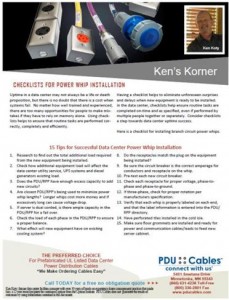KEN'S KORNER - Power Cable Installation Checklist
15 Tips for Successful Data Center Power Whip Installation
Looking for something to read that is both entertaining and enlightening, how about “The Checklist Manifesto” by Dr. Atul Gawande.
A book about checklists might not sound too enthralling, but Dr. Gawande manages to introduce enough interesting stories and case history around the use of checklists to hold your attention. More importantly a tremendous case is made for checklists and the value they bring to those who employ them in various ways, from builders and engineers, to pilots, doctors, and even David Lee Roth while on tour.
Checklists provide two main benefits, first by recognizing the fallibility of human memory and attention, especially when it comes to mundane, routine tasks that are easily overlooked under the strain of pressure and events. The second benefit of checklists is reminding us of the minimum steps to perform a task, providing the opportunity for verification while instilling a higher level of discipline in the process.
Checklists and the Data Center
Uptime in a data center may not always be a life or death proposition, but there is no doubt that there is a cost when systems fail. No matter how well trained and experienced, there are too many opportunities for people to make mistakes if they have to rely on memory alone. Using checklists helps to ensure that routine tasks are performed correctly, completely and efficiently.
Having a checklist helps to eliminate unforeseen surprises and delays when new equipment is ready to be installed. Here is a checklist for installing new power whips.
Checklist for Power Whip Installation
Research to find out the total additional load required from the new equipment being installed.
• Research to find out the total additional load required from the new equipment being installed.
• Check how additional equipment load will affect the data center utility service, UPS systems and diesel generators existing load.
• Does the PDU/RPP have enough excess capacity to add new circuits?
• Are closest PDU/RPP being used to minimize power whip lengths, longer whips cost more money and if excessively long can cause voltage drop.
• If server is dual corded is there ample capacity in PDU/RPP for a fail over.
• Check the load of each phase in the PDU/RPP to ensure a proper balance.
• What effect will new equipment have on existing cooling system?
• Do the receptacles match the plug on the equipment being installed?
• Be sure the circuit breaker is the correct amperage for conductors and receptacle on the whip.
• Pre-test each new circuit breaker.
• Check each receptacle for proper voltage, phase-to-phase and phase-to-ground.
• If three-phase, check for proper rotation per manufactures specification.
• Verify that each whip is properly labeled on each end, and that the label information is entered into the PDU/RPP directory.
• Have perforated tiles installed in the cold isle.
• Make sure floor grommets are installed and ready for power and communication cables/leads to feed new server cabinet.
In the data center, checklists help ensure routine tasks are completed on-time and as specified, even if performed by multiple people together or separately. Consider checklists a step towards date center uptime success.
Ken Koty

